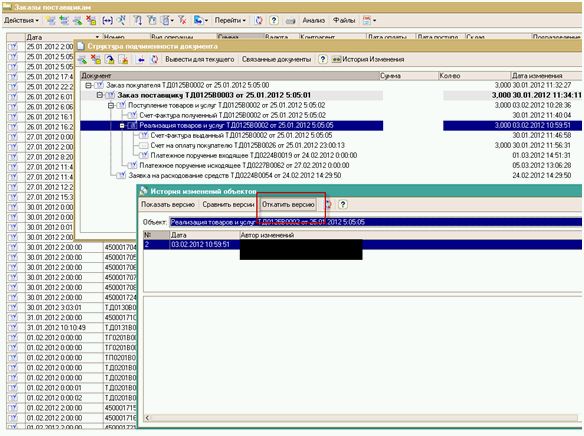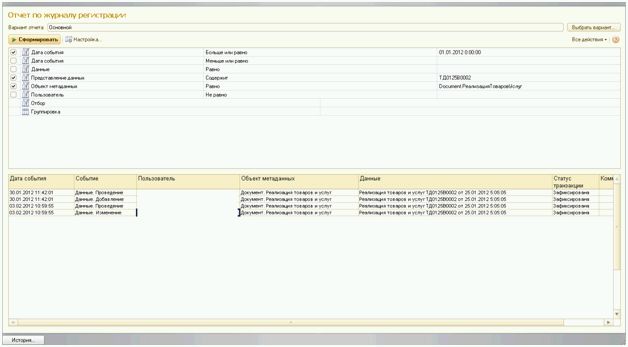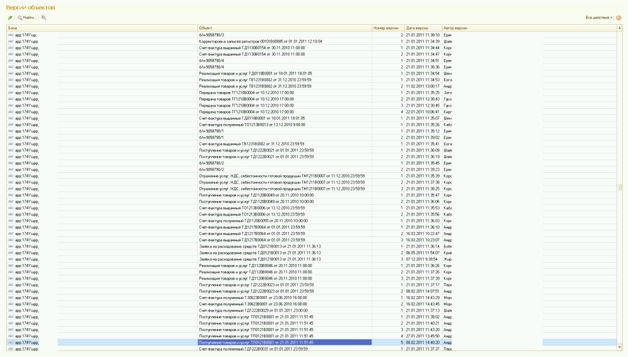Dot rollback changes. Versioning 1C good or evil. The author's idea of a system for collecting versions on 1C systems
Everyone wants to control his life, to know all the answers. The same is true of information systems. But here everything is much more complicated, since your life depends on 3-10 people. And in the information system 200 and 1000 employees often work. And it is in such a flow of information that it is vital to know what has changed in essence and who specifically made these changes.
This task was set for a long time by the developers of 1C and now, we are pleased with the appearance of a more or less working mechanism. However, storing versions in the database itself quickly leads to its growth. This article is devoted to the elimination of this deficiency.
 "
"
Versioning 1C.
The mechanism of versioning objects is used to audit changes in the objects of the information base in the context of time and allows you to answer the questions of WHO, WHEN and WHAT you changed. Reference objects and documents can act as versioned objects. The mechanism is configured in the form of program settings and is available to the user with the “Full rights” role. The setting consists of activating the mechanism and setting the mode of collecting versions of documents and reference books.
However, every cloud has a silver lining. Over time, the number of changed records is comparable in volume to the main data, and then simply goes into a “gap” and exceeds all reasonable limits. What begins to significantly affect the speed of the system.
To eliminate this drawback, it is logical to withdraw this data and store it separately. This is all the more logical when there are more than one information systems that need to be audited.
To solve this problem, our team has developed a software product with the following functionality:
1. Collect data about changed objects in the background according to the schedule. In the workbase, only the last change remains, the number of the "last" is regulated. So you can eliminate the "swelling" of the base and at the same time you can, in case of anything, return the damaged document in a second.

2. Report generation in terms of audit (who, what, when changed). I really like "Security Guards."

')
3. Everything that has ever changed in systems. And all versions of modified objects in one place in a separate database. The system collects both versions and logs from the specified systems.

4. But when it is necessary to audit the changes, we have a complete picture.

In general, a useful system turned out. On the one hand, it eliminates the uncertainty of change, and on the other hand, it disciplines users because there is no possibility to shift the blame on the “last”.
This task was set for a long time by the developers of 1C and now, we are pleased with the appearance of a more or less working mechanism. However, storing versions in the database itself quickly leads to its growth. This article is devoted to the elimination of this deficiency.
 "
"Versioning 1C.
The mechanism of versioning objects is used to audit changes in the objects of the information base in the context of time and allows you to answer the questions of WHO, WHEN and WHAT you changed. Reference objects and documents can act as versioned objects. The mechanism is configured in the form of program settings and is available to the user with the “Full rights” role. The setting consists of activating the mechanism and setting the mode of collecting versions of documents and reference books.
However, every cloud has a silver lining. Over time, the number of changed records is comparable in volume to the main data, and then simply goes into a “gap” and exceeds all reasonable limits. What begins to significantly affect the speed of the system.
To eliminate this drawback, it is logical to withdraw this data and store it separately. This is all the more logical when there are more than one information systems that need to be audited.
To solve this problem, our team has developed a software product with the following functionality:
1. Collect data about changed objects in the background according to the schedule. In the workbase, only the last change remains, the number of the "last" is regulated. So you can eliminate the "swelling" of the base and at the same time you can, in case of anything, return the damaged document in a second.

2. Report generation in terms of audit (who, what, when changed). I really like "Security Guards."

')
3. Everything that has ever changed in systems. And all versions of modified objects in one place in a separate database. The system collects both versions and logs from the specified systems.

4. But when it is necessary to audit the changes, we have a complete picture.

In general, a useful system turned out. On the one hand, it eliminates the uncertainty of change, and on the other hand, it disciplines users because there is no possibility to shift the blame on the “last”.
Source: https://habr.com/ru/post/174495/
All Articles